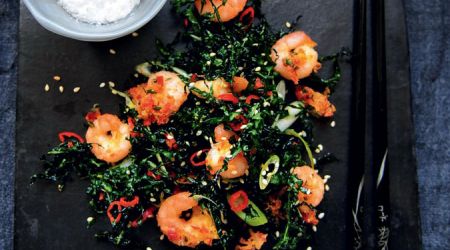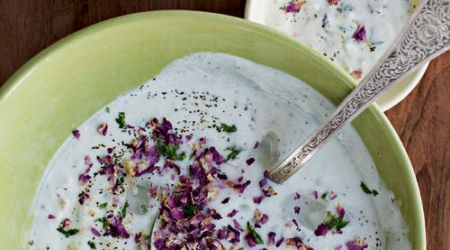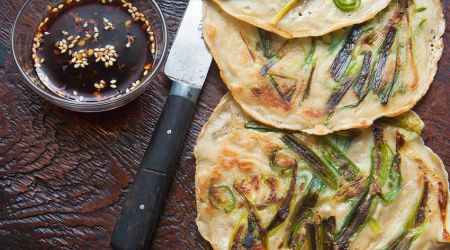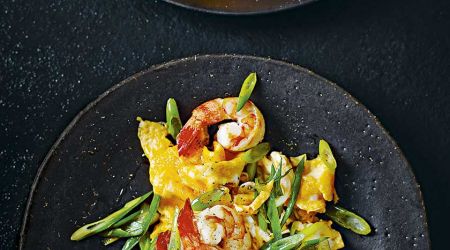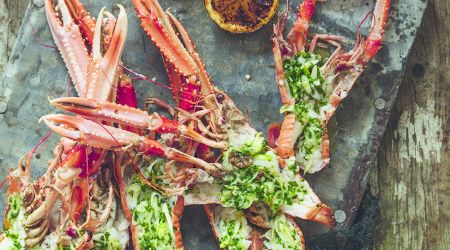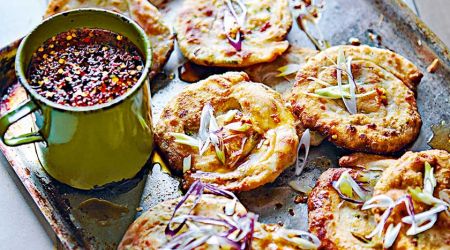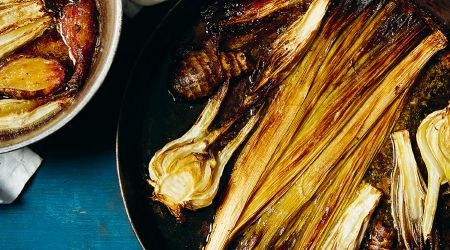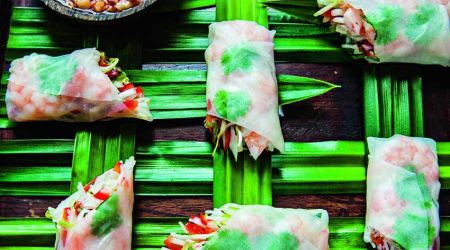Spring Onions
Forgo the garnish and use these bright bunches for crisp salads and light dishes, says Clarissa Hyman. Or simply grill on their own and dip... with recipes by Linda Tubby
He says spring onions and she says green onions and they say salad onions and someone else says scallions – and I say to hell with it. Just one look reminds me of the great Chinese poet Tu Fu who described them beautifully as grass-green bundles with bulbs as delicate as white jade, bringing inner warmth and comfort when there was a chill in the air. He then disconcertingly goes and calls them winter onions, an early example of confusing nomenclature amongst the onion family that persists to this day.
Spring onions, Allium cepa, vary in shape and size from small and bulbous to long and slender-smooth; the skin covering the bulb can be either white or deep red fading to white but there is no significant difference in taste. they have a long season, although they are now available year-round thanks to imports and salads grown under glass. The arrival of fresh outdoor British spring onions, however, adds a touch of sharp freshness to days when the barometer seems stuck at dull, grey and cloudy.
They are actually the shoots of immature onions, harvested two to three months after planting and eaten fresh rather than dried. If these ‘thinnings’ were left in the ground, the bulbs would simply develop into full-sized onions. The growing season extends well beyond the spring because they can be sown successionally to provide a constant crop through till the last autumn harvest.
Many British people, at least of a certain age, associate pungent, raw spring onions with limp leaf salads and salad cream. This may be a reason why many still avoid them other than for token decoration, but they add interest to sliced tomatoes, potato salad and bland avocado, as well as bite to dips and wraps.
To prepare them, chop off the roots and remove the topmost part of the green (ideally chuck them in the stock pot), then use whole or sliced, either the green or white or both, as wished. Unless used sparingly, however, the flavour can be overwhelming. Cooking brings out a more subtle, concentrated flavour, although they may need to be blanched first before being braised or grilled.
When they are griddled in a heavy, dry frying pan over a high flame, for example, they develop a deliciously faint taste of brown sugar. Or boil or steam the spring onions briefly, brush with olive oil and quickly sear on both sides to make grill marks. In Tarragona, Spain, the Catalans hold a festival every January to celebrate the calçot, a local variety that is grilled, dipped into romesco sauce and consumed sword-swallower style.
They are an essential component of Chinese and South-East Asian cookery. The late Yan-kit So called spring onions, fresh ginger and garlic the Chinese ‘kitchen trinity’. It is worth noting, however, that most Chinese green or spring onions, despite the words of Tu Fu, lack the characteristic swollen bulbs. As Chinese food expert Fuchsia Dunlop explains, they are used to refine the flavours of meat and fish and to give an appetising fragrance and taste to all kinds of dishes. Chinese varieties are slightly different to those commonly available in the West, and she advises using the green parts for garnishes and the thicker, more strident whites in marinades and stews. In northern China, a special onion, a cross between a spring onion and a leek, has a delicate texture, can be eaten raw and is one of the traditional garnishes for Peking duck.
You can substitute young spring onion tops for chives, or use the bulbs in place of baby leeks. Or add to French-style peas simmered in butter with lettuce. Irish champ is a dish fit for kings when spring onions briefly simmered in milk are stirred into hot, buttery mashed potatoes.
Lindsey Bareham in her book Onions Without Tears suggests several recipes for sauces made with spring onion, including Korean Dipping Sauce, East Asian Mayo and Cooked Tomato sauce with Spring Onion. But there’s little new under the sun: an early 19th-century recipe by Mrs Rundell describes an old Staffordshire way of frying spinach leaves, parsley and ‘green’ onions in butter to serve with grilled calves’ liver, bacon and fried eggs.
They are easy to grow in a sunny site with good drainage, and there are now several varieties which are grown specifically as salad ‘spring onions’.
Gardener and author Sarah Raven suggests interspersing them amongst carrots to protect against root fly. White Lisbon is a popular variety and you could also try the red-bulbed North Holland Blood Red Redmate, a particularly tasty variety that will grow into a good full-sized onion if left alone.
When buying spring onions, either in bunches or pre-packed, look for clean specimens with firm white bases and undamaged green tops. Any that are limp or slimy are past their best. The thinner the spring onion, the milder it will be. They rarely need any more than a brief rinse under cold running water. Only the roots need trimming, though you may also wish to discard any coarse green leaves or blemished outer layers.
To make spring onion flowers, or tassels or brushes, trim the onions to 10cm lengths, cut a cross at each end to a depth of 2cm and drop them into iced water and leave until the ends spring out into ‘flowers’. It’s surprisingly easy and effective and gives a realistic Chinese takeaway look. Whatever name you call it by.
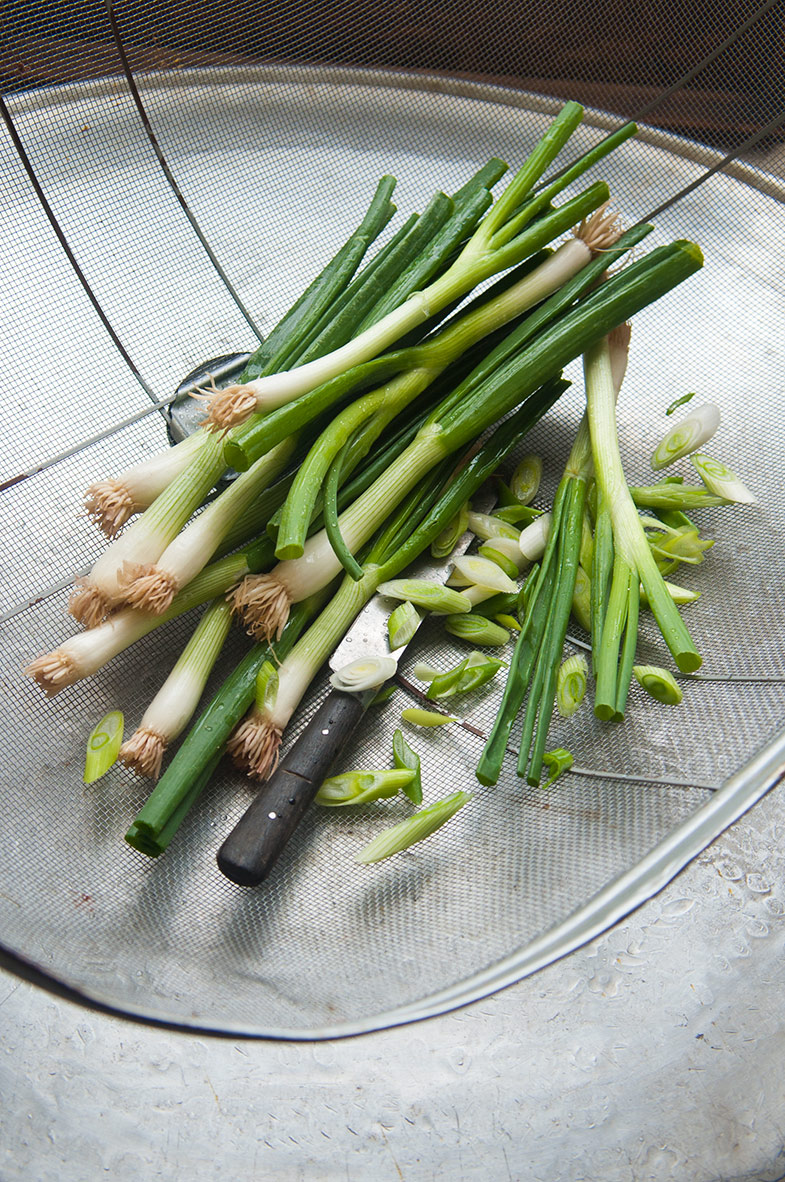
Recipes
Get Premium access to all the latest content online
Subscribe and view full print editions online... Subscribe


